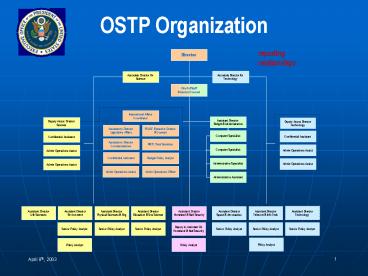OSTP Technology Division - PowerPoint PPT Presentation
Title:
OSTP Technology Division
Description:
S. 189 '21st Century Nanotechnology Research and Development Act' Senator Wyden ... H.R. 5669 'Nanoscience and nanotechnology Advisory Board Act' Rep. Honda ... – PowerPoint PPT presentation
Number of Views:119
Avg rating:3.0/5.0
Title: OSTP Technology Division
1
OSTP Organization
reportingrelationships
2
Physical Sciences Group
3
Physical Science Policy Topics
Participation Balance (phys. sci. vs life sci) E
ducation Workforce Student Visas Openness vs. Se
curity Technology Programs/Tech Transfer IT RD
Space Station Nuclear Power Yucca
Mountain Homeland/National Security Nanotech (NN
I)
- Lead
- 2004 Phys. Sci. Budget
- ITER/Fusion
- Astronomy/Astrophysics
- Underground Laboratory
- High Energy Physics
- Nuclear Power
- Physics of the Universe
- Scientific Facilities
- Research Business Models
- Neutron Scattering
4
The National Nanotechnology Initiative
5
How is the NNI currently managed?
NSET (nanoscale science and engineering technolog
y subcommittee includes reps from each participat
ing agency, OSTP, NSTC, OMB, NRC)
NNCO
participating agencies...
6
National Science and Technology Council
Homeland National Security Committee
Environment Natural Resources Committee
Technology Committee
Science Committee
Technology Development Subcommittee
Networking Information Technology Subcommittee
NITRD Working Group
NITRD National Coordination Office
Nanoscale Science, Engineering
Technology Subcommittee
NSET Working Group
NSET National Coordination Office
Biotechnology Subcommittee
Also reports to Science Committee
Aerospace Subcommittee
Infrastructure Subcommittee
Also reports to HS/NS Committee
active
proposed
7
Investment is currently parsed among 5 domains
- Fundamental research ( 228 million 03)
- Grand Challenges ( 267 million)
- Research Infrastructure - (100 million)
provide basic tools for research, i.e. new tools
and software, and the physical infrastructure,
including central user facillities - Centers of Excellence ( 108 million) large
group research and education activities - Societal Implications, education, workforce
training ( 16 million)
8
Current grand challenges
- Advanced Chem/Bio/Rad and Explosives Detection
(The UC Berkeley BioCom chip for detecting PSA) - Manufacturing at the nanoscale (Dip Pen
nanolithography - northwestern) - Nanoscale instrumentation and metrology (NIST
nanofabricator) - Nanostructured materials by design (Carbon
nanotubes - Rice) - Nano-Electronics, -Photonics and magnetics
(molecular electronics - UCLA) - Healthcare, Therapeutics and Diagnostics (Peptide
nanotubes as antibiotics they puncture the
cell wall - NIH) - Energy Conversion and Storage (nanorod polymer
solar cell flexible sheets - Berkeley) - Microcraft and Robotics (biological/molecular
motors Cal Tech/UCLA) - Nanoscale processes for Environmental Improvement
(nanoparticle water filtration Lehigh
University)
9
The NRC review of the NNI
- Needs clear, compelling overarching strategy
- Needs to encourage interagency collaborations
- Needs external advisory board (PCAST)
- Better technology transfer/industrial
participation
10
Legislation in House and Senate
- Senate
- S. 189 21st Century Nanotechnology Research and
Development Act Senator Wyden (Fall 2002,
reintroduced in Winter 2003) - House
- H.R. 5669 Nanoscience and nanotechnology
Advisory Board Act Rep. Honda (Fall 2002) - H.R. 766 The Nanotechnology Research and
Development Act of 2003 - Bills modeled after the NNI but include
mechanisms to address the NRC recommendations. - Key difference is the addition of an external
advisory board. OSTP proposes using the PCAST to
serve this role.
11
What is OSTP doing this year?
- OSTP appointed the first full-time director of
the National Nanotechnology Coordination Office
(NNCO) Dr. Clayton Teague - OSTP is improving the management structure of the
NNI adding an IWG, elevating the NSET to
achieve buy-in at higher levels. - Presidents Council of Advisors on Science and
Technology (PCAST) will serve as external
advisory board. - PCAST has been tasked to review the NNI
- Develop strategic plan with goals and objectives
- Develop new grand challenges
- Develop metrics
12
What else is OSTP planning?
- Effort to build new bridges between physical and
life sciences - Bio-nano steering committee has been formed
- More emphasis on societal implications
- More emphasis on technology transfer
- More emphasis on metrics
13
Facilities Policy Issues Under Discussion
- Priority Setting and Intellectual Stewardship
- too many facilities, too little money, what are
priorities? - Mega-Facilities
- impact of major facilities and stewardship for
scientific fields - Mature Facilities
- old facilities never seem to die
shutdown/stewardship transfer, upgrade paths - Best practices for long-range planning for
facilities - Program business models
14
IWG on the Physics of the Universe
What is the Dark Matter? What is Dark Energy? Ho
w did the Universe Begin? Did Einstein have the l
ast word on gravity? What are the masses of the n
eutrinos and how have they shaped our universe?
How do cosmic accelerators work and what are they
accelerating? Are protons unstable? What are ne
w states of matter at exceedingly high density
and temperature? (HED) Are there additional space
-time dimensions? How were elements from iron to
uranium made? Is a new theory of matter and light
needed at the highest energies?
NAS Committee on the Physics of the Universe
Report (Michael Turner Chair) 11 questions for t
he 21st Century Subsumed Decadal Survey, HEPAP L
RP, NSAC LRP, HED Study, etc. Provides intellectu
al framework Not all of the recommendations are n
ew starts OSTP has formed an IWG to develop a r
esponse to the quarks to cosmos report.
it is clear to me that the fates of deep space
astronomy and particle physics are strongly
entwined. In the long run, the future of
particle physics lies in space-based experiments,
and its productivity will depend on having a
model of nature that is complete enough to
exploit cosmic phenomena as a guide to theory.
Now is the time to begin preparing for the long
run. John H. Marburger, III Presidents Scienc
e Advisor and Director, Office of Science and Tec
hnology Policy from Remarks given at SLACs 40t
h Anniversary Celebration

